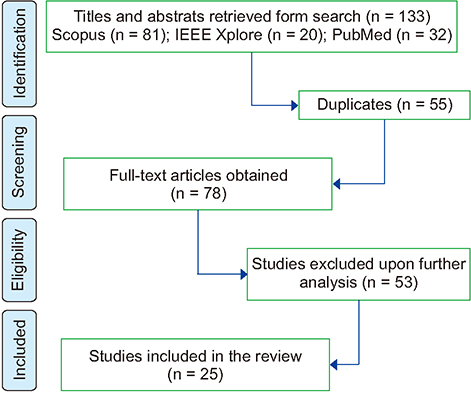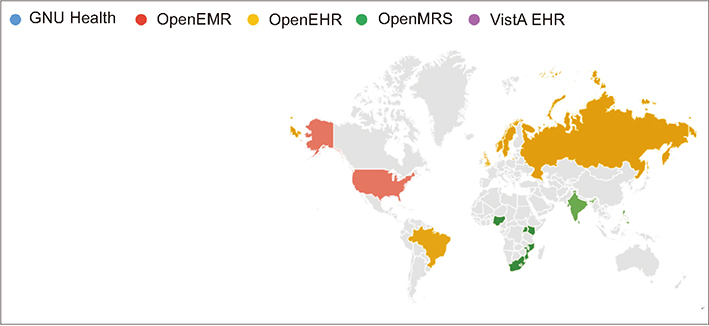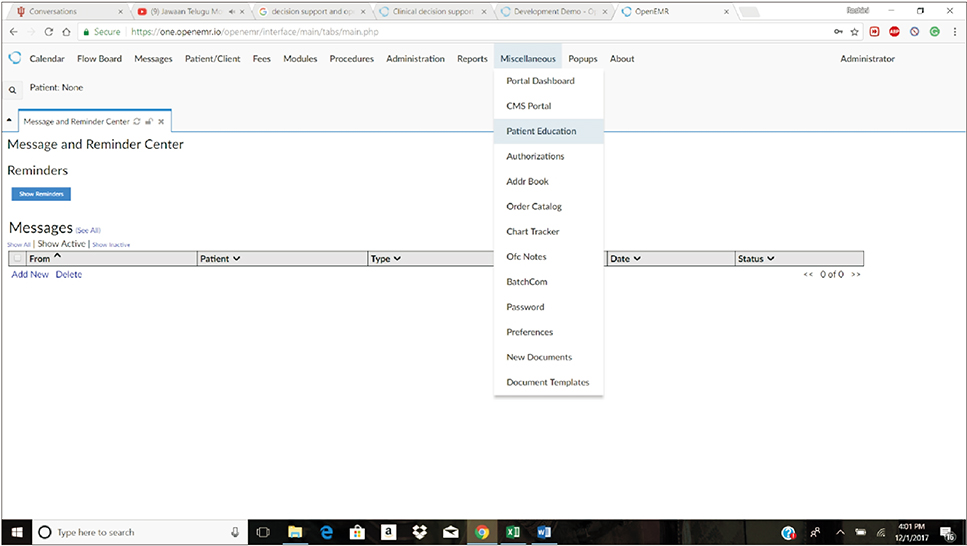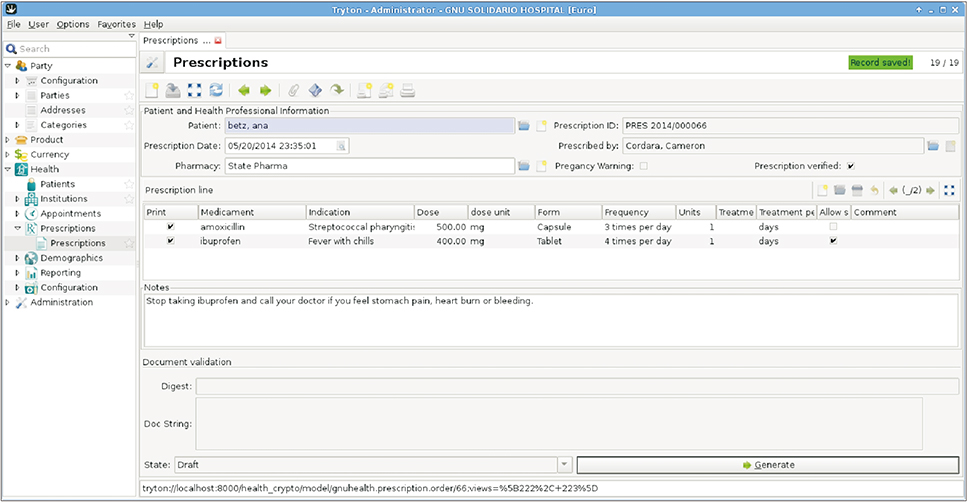Healthc Inform Res.
2019 Apr;25(2):89-98. 10.4258/hir.2019.25.2.89.
Comparison of Open-Source Electronic Health Record Systems Based on Functional and User Performance Criteria
- Affiliations
-
- 1Department of BioHealth Informatics, Indiana University-Purdue University Indianapolis, Indianapolis, IN, USA. saptpurk@iupui.edu
- 2Dotter Institute, Oregon Health and Science University, Portland, OR, USA.
- KMID: 2445005
- DOI: http://doi.org/10.4258/hir.2019.25.2.89
Abstract
OBJECTIVES
Open-source Electronic Health Record (EHR) systems have gained importance. The main aim of our research is to guide organizational choice by comparing the features, functionality, and user-facing system performance of the five most popular open-source EHR systems.
METHODS
We performed qualitative content analysis with a directed approach on recently published literature (2012-2017) to develop an integrated set of criteria to compare the EHR systems. The functional criteria are an integration of the literature, meaningful use criteria, and the Institute of Medicine's functional requirements of EHR, whereas the user-facing system performance is based on the time required to perform basic tasks within the EHR system.
RESULTS
Based on the Alexa web ranking and Google Trends, the five most popular EHR systems at the time of our study were OSHERA VistA, GNU Health, the Open Medical Record System (OpenMRS), Open Electronic Medical Record (OpenEMR), and OpenEHR. We also found the trends in popularity of the EHR systems and the locations where they were more popular than others. OpenEMR met all the 32 functional criteria, OSHERA VistA met 28, OpenMRS met 12 fully and 11 partially, OpenEHR-based EHR met 10 fully and 3 partially, and GNU Health met the least with only 10 criteria fully and 2 partially.
CONCLUSIONS
Based on our functional criteria, OpenEMR is the most promising EHR system, closely followed by VistA. With regards to user-facing system performance, OpenMRS has superior performance in comparison to OpenEMR.
Keyword
MeSH Terms
Figure
Reference
-
1. Bhandari G, Snowdon A. Adoption of open source software in healthcare. In : Phillips-Wren G, Jain LC, Nakamatsu K, editors. Advances in intelligent decision technologies. Heidelberg: Springer;2010. p. 365–372.2. Saebi T, Foss NJ. Business models for open innovation: matching heterogeneous open innovation strategies with business model dimensions. Eur Manag J. 2015; 33(3):201–213.
Article3. Morgan L, Finnegan P. Benefits and drawbacks of open source software: an exploratory study of secondary software firms. In : Feller J, Fitzgerald B, Scacchi W, editors. Open source development, adoption and innovation. Boston (MA): Springer;2007. p. 307–312.4. Reynolds CJ, Wyatt JC. Open source, open standards, and health care information systems. J Med Internet Res. 2011; 13(1):e24.
Article5. Ratib O, Rosset A, Heuberger J. Open Source software and social networks: disruptive alternatives for medical imaging. Eur J Radiol. 2011; 78(2):259–265.
Article6. Zaidan AA, Zaidan BB, Al-Haiqi A, Kiah ML, Hussain M, Abdulnabi M. Evaluation and selection of open-source EMR software packages based on integrated AHP and TOPSIS. J Biomed Inform. 2015; 53:390–404.
Article7. Goldwater JC, Kwon NJ, Nathanson A, Muckle AE, Brown A, Cornejo K. Open source electronic health records and chronic disease management. J Am Med Inform Assoc. 2014; 21(e1):e50–e54.
Article8. Blumenthal D, Tavenner M. The “meaningful use” regulation for electronic health records. N Engl J Med. 2010; 363(6):501–504.
Article9. de Abajo BS, Ballestero AL. Overview of the most important open source software: analysis of the benefits of OpenMRS, OpenEMR, and VistA. In : Rodrigues JJ, de la Torre-Diez I, de Abajo BS, editors. Telemedicine and e-health services, policies, and applications: advancements and developments. Hershey (PA): IGI Global;2012. p. 315–346.10. Tripathi M. EHR evolution: policy and legislation forces changing the EHR. J AHIMA. 2012; 83(10):24–29.11. Jones B, Yuan X, Nuakoh E, Ibrahim K. Survey of open source health information systems. Health Inform. 2014; 3(1):23–31.
Article12. Karopka T, Schmuhl H, Demski H. Free/Libre open source software in health care: a review. Healthc Inform Res. 2014; 20(1):11–22.
Article13. Kiah ML, Haiqi A, Zaidan BB, Zaidan AA. Open source EMR software: profiling, insights and hands-on analysis. Comput Methods Programs Biomed. 2014; 117(2):360–382.
Article14. Kashfi H. An openEHR-based clinical decision support system: a case study. Stud Health Technol Inform. 2009; 150:348.15. Syzdykova A, Malta A, Zolfo M, Diro E, Oliveira JL. Open-source electronic health record systems for low-resource settings: systematic review. JMIR Med Inform. 2017; 5(4):e44.
Article16. Alsaffar M, Yellowlees P, Odor A, Hogarth M. The state of open source electronic health record projects: a software anthropology study. JMIR Med Inform. 2017; 5(1):e6.
Article17. Oza S, Jazayeri D, Teich JM, Ball E, Nankubuge PA, Rwebembera J, et al. Development and deployment of the OpenMRS-Ebola electronic health record system for an Ebola treatment center in Sierra Leone. J Med Internet Res. 2017; 19(8):e294.
Article
- Full Text Links
- Actions
-
Cited
- CITED
-
- Close
- Share
- Similar articles
-
- Satisfaction with Paper-Based Dental Records and Perception of Electronic Dental Records among Dental Professionals in Myanmar
- Diffusion of Electronic Medical Record Based Public Hospital Information Systems
- Nurses’ Experiences with the Use of Electronic Nursing Record: A Qualitative Study
- Needs Assessment for Functionalities in Electronic Health Record Systems in General Hospitals
- The Adoption of Electronic Medical Records and Decision Support Systems in Korea







